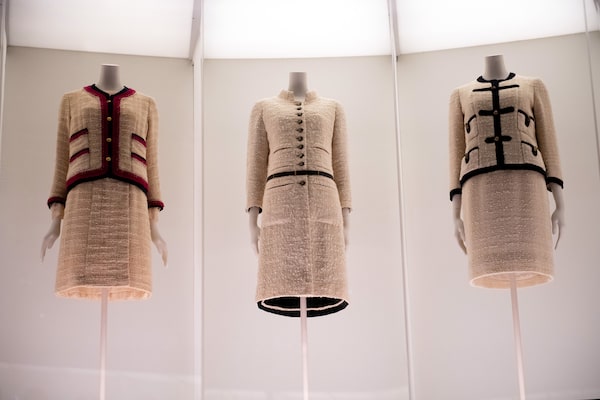
Victoria and Albert Museum's exhibition Gabrielle Chanel: Fashion Manifesto.chanel
“The more we tried to get close to her, the further away she seemed to get.” That’s how Oriole Cullen, the fashion curator at London’s Victoria and Albert Museum, describes the process of working on Gabrielle Chanel: Fashion Manifesto – the current blockbuster exhibition dedicated to the work of French couturière Gabrielle (Coco) Chanel, founder of the eponymous brand.
The show, which continues until Feb. 25, is a remounting of an exhibition that opened and closed and opened again at Paris’s Palais Galliera in the middle of the pandemic in 2021. The V&A’s version maintains its title and spirit but adds in 100 new garments sourced from its own collection plus elements of Chanel’s collaborations with British textile mills and an exploration of the designer’s connection to stage and screen.
Fashion exhibitions like this one have become important brand-building opportunities for luxury houses, which often sponsor the shows and open up their own archives for research. That raises important questions about how fashion history and myth-making co-exist in their galleries. As Cullen noted in an interview shortly after the show’s opening, such muddy provenance is something that defines Gabrielle Chanel herself. “I think that was always her design and her intent in a way,” Cullen says. “That she would remain, somehow, this public figure in the sense that she was the face of her brand but, in the sense of her private life, she always wanted to remain mysterious.”

Chanel
How does something that exists as an exhibition somewhere else evolve when it comes into your hands?
It’s a very good question. It’s always much easier just to work from scratch on something than it is to adapt. We had a really great conversation with our colleagues at the Galliera and also the team at the Patrimoine [Chanel’s own archive] to slightly pivot the show toward more of a V&A style show. Obviously, the Palais Galliera is a fashion museum in Paris so it has a really wonderful, informed audience. People know instantly who Gabrielle Chanel is. The V&A has a much wider demographic who come to see shows so a lot of people aren’t even aware of how Gabrielle Chanel is related to “Coco.” We’re starting from a very different perspective and so I think we wanted to try and situate the visitor at the beginning of the show, let them know about Chanel’s background.
I get the impression that the textile aspect of the show is a big part of that shift?
We really wanted to highlight that because it is quite integral to Chanel’s way of designing and her way of working. Textiles play a really important role and not only in her choice of unusual textiles and the subversive idea of bringing very practical, humble materials into couture but also the fact that she was not someone who sketched. She was someone who worked on the body, very much hands on. I think it’s very lovely to have [Chanel’s] handprint as the first object in the show, talking about her as a sort of artisan and hands-on person and how much touch and textile relates to that.
Were all the British textile mills part of the original show?
No, that’s a new layer as well. There are still some wonderful textile firms in Britain today but, very sadly, the scale of that manufacturing has really declined. A lot of those firms are no longer in business so it was very interesting to go on almost a wild goose chase trying to track down these firms.
The show touches on the idea of myth and brand and fashion history and how those things all mingle together.
It’s very interesting because there’s so much myth around Chanel and legend about her and I think, for us, at various points, it was really important to go back to archival sources and original documents to try and work it out. There are so many biographies and so many of them just repeat what other biographers have said and you get this tumble effect where things become received as truth but, actually, they start off in some little conjecture in someone’s biography.
That was really important for us, as much as we could, to go back to original sources because, of course, the origin of all these myths is Chanel herself. She’s sadly coming from a very impoverished background, something that was quite shameful at the time so she was always hiding this and creating these myths and these stories. It’s very difficult, often, to get to the truth behind things.
How does that affect the way fashion history contextualizes her?
Along with the archive documents, the other objects that are important are the garments and the dresses and gowns themselves. There’s truth and fact in those so it’s almost contextualizing her through the objects, which was the Galliera’s intent originally. They speak volumes and that’s the wonderful thing about an exhibition as opposed to a book, that people and visitors can come and make up their own mind and look at something and think “wow, it’s beautifully made. It’s so simple but actually the finish, the cut is incredible.” It’s realizing fashion history right in front of you. Everyone knows Chanel is a legendary designer. She changed fashion. But, actually how and why? To see those 100-year-old garments right in front of you and to see how timeless they are, it is quite wonderful to show that rather than just telling.
This interview has been condensed and edited.
The Globe and Mail travelled to London as a guest of Chanel. The company did not review or approve this article prior to publication.

Chanel